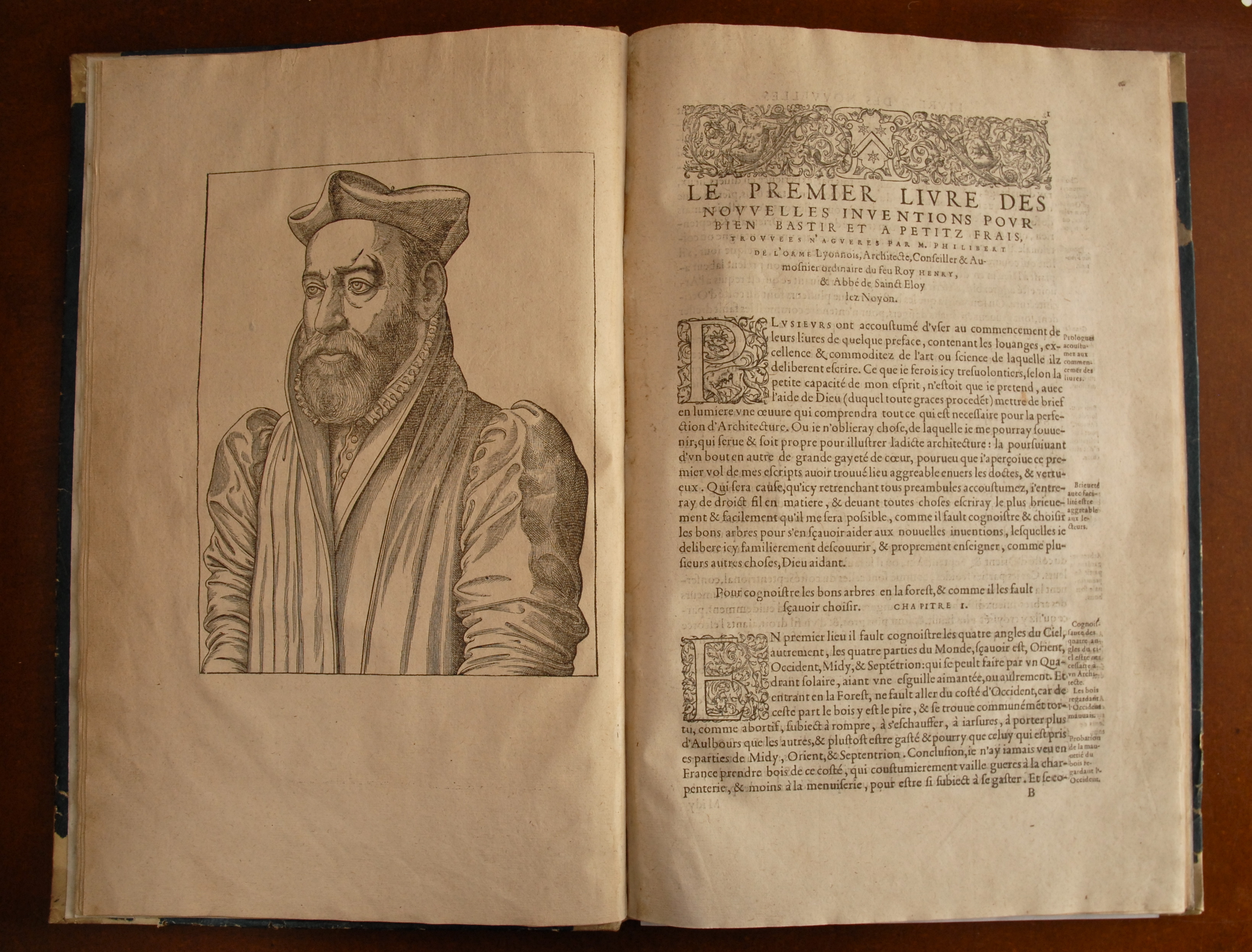DE L’ORME, Philibert
BEAUTIFULLY PRINTED AND ILLUSTRATED
Nouvelles inventions pour bien bastir
Paris, De l᾽imprimerie de Hierosme de Marnef, & Guillaume Cauellat, 1576£6,500.00
Folio. pp. [xii], 94, [vi]. A-H6, I8. “De Marnef’s pelican device (similar to Renouard 738) on the title page. Architectural title-border, the border used on the 1572 Vitruvius. The thirty four [full-page] woodcuts are the blocks designed for Fédéric Morel’s first edition of this text, printed in 1561. The emblematic headpiece from Morel’s 1567 edition of L’Orme’s Le Premier tome de L’architecture was also used here by de Marnef, along with an armorial headpiece of his own (Renouard 744). Arabesque tailpieces. A number of the initials are close copies of those used by Morel in 1561. Large initials in other styles. The colophon on the recto of leaf I8 is printed within a border of type ornaments, with another Marnef pelican device (Renouard 729) on the verso. Roman letter, small Roman marginalia” Mortimer Harvard. Beautiful full page woodcut portrait of De L’Orme on verso of A6, (lacking in Harvard copy), ex dono of the heirs of Henri Corbault to the Jesuit College at Mons, Hannovi (Hanover) added at a later date, small elegant masonic stamp, with monogram C.K., incorporating artists paraphernalia in lower blank margin of title. Small light oil stain in title and next, margins a little thumb marked or dusty in places, verso of last a little dusty. A good, crisp copy, in early nineteenth three quarter vellum over marbled paper boards.
The third edition, using all the woodcuts of the first (1561), of this important and beautifully printed and illustrated treatise. De L’Orme (c.1510-1570),was one of the great Renaissance architects of the 16th century, the first French architect to possess the universal outlook of the Italian masters without merely imitating them. Mindful that French architectural requirements differed from the Italian, and respectful of native materials, he founded his designs on sound engineering principles, fusing the orders with a delicacy of invention, restraint, and harmony characteristic of purest French classicism.
“the simple woodcuts are excellent examples of perfectly understood and clearly presented structural details and show De Lorme’s system of built up timber roofs, requiring no ties or heavy timbers, which was successfully used as late as the end of the eighteenth century in the Halle-aux-Bles in Paris. Indeed, De Lorme is unique among the early writers on architecture for the emphasis he placed upon construction. ..A copy of the 1576 edition was in the library of Thomas Jefferson (Sowerby, No. 4183).” Fowler (on the first edition).
“Of the leading early French architectural writers, De Lorme is the most interesting and original, but is less distinguished an artist than Jean Bullant and is less versatile as a draughtsman than Du Cerceau. De Lorme has been called the first modern architect because of his original contributions to construction and his skill as an organizer, but Blomfield says that ‘It was by his strong individuality rather than by his art that De Lorme won, and has maintained, his place among the great Frenchmen of the sixteenth century’ (Blomfeld French Arch. I Vol. I p. 92)” Fowler.
“First published in 1561 the ‘Nouvelles inventions (the treatise on roofs) describes ingenious techniques which replace the use of large rectilinear pieces of square section, with small flat and curved elements assembled like keystones. This new invention appears to comply with a rational approach in industrial terms, in that it keeps costs down, standardises construction and means that a relatively unqualified workforce can be employed. These innovative ideas, which were too revolutionary to achieve much success despite the persuasive force of the author, were not put into practice properly until after 1750, the date when the modern science of building properly emerged.” Vaughan Hart ‘Paper Palaces’ “The treatise “Le nouvelles inventions” …. is a milestone in the history of wood inventions as it contains different conceptions of how wood can be used. Anyone who wishes to study wooden roofing has to consider the theories of this French architect.” Maria Rita Campa.
BM STC Fr. C16th p. 287. Brunet, II 578. Brun p. 182. Harvard I Fowler 98 (1st edn.) Not in Murray or Rothschild.In stock






